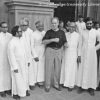Goa is abuzz with excitement as vintage bike and car owners, users, collectors and fans are decking […]

KRISHNA MENON PUSHED NEHRU FOR LIBERATION!
Dec 23- Dec 29 2023, Stray Thoughts December 22, 2023By Rajan Narayan
AND a few stray thoughts for yet another Saturday. For a Saturday following the week when Goa celebrated its 62nd anniversary of Goa Liberation Day. For a Saturday following the week when for the first time Serendipity is charging visitors a nominal Rs99 for some of its events. For a Saturday following the week when Chief Minister Pramod Sawant advocated an open schooling system for the benefit of those who fail their 10th and 12th SSC board exam. For a Saturday following the week when it was reported that the IT companies had reduced their intake of fresh engineering graduates by 40%. For a Saturday following the week when Porvorim MLA Rohan Khaunte asked Goans to fight for liberation from garbage.
AND a few stray thoughts on Goa observing its 62nd Liberation Day. It may be recalled that Goa was liberated on December 19, 1961 from 456 years of Portuguese colonial rule. The credit for the liberation has been given to Jawaharlal Nehru, the first prime minister of independent India. On the contrary it was Nehru who delayed the liberation of Goa. This was because Nehru who was a believer of the non-aligned movement was committed to solving problems through peace and not through a show-off of armed force might. Nehru lived to regret it when a country which he believed was a close friend, China, invaded India and occupied a large part of what is now Arunachal Pradesh.
Jawaharlal Nehru was under pressure from freedom fighters and others to liberate Goa with armed forces right from 1947. Nehru appeared confident that he would persuade the Portuguese to leave India politely. He was encouraged by the settlement with France over its colony Pondicherry, now Puducherry. The Portuguese dictator António de Oliveira Salazar was a much tougher nut to crack. Salazar lobbied internationally to prevent India from liberating Goa through armed intervention. Salazar had the support of countries like UK, US and France.
However, even when efforts were on for the liberation of Goa Portugal did not accept it. It went to the United Nations and appealed against Goa’s liberation. In the United Nations again the USA, UK and France supported Portugal. Indeed, most of the world including John F Kennedy who was then US president, express shock when Indian armed forces entered Goa and freed it from colonial rule. President John Kennedy is reported to have acidly remarked the fox had entered the hen house.
There were several countries in the Security Council of the UN which opposed civilized attempts for the liberation of Goa. We think due credit was never given to the then defense minister VK Krishna Menon at the time of liberation. It was finally Krishna Menon who pushed the reluctant Nehru to agree to a forced liberation of Goa. Till the last moment Nehru tried to delay it but a determined Krishna Menon overruled Nehru and ordered the armed forces to storm Goa, all behind Nehru’s back.
India’s air force played a very significant role in the liberation of Goa. It was the Indian air force which disabled the Portuguese air force and afterwards Nehru was very embarrassed and apologetic about Goa’s liberation. The Congress party did not play any role even in the freedom struggle.
The struggle for Goa’s freedom was driven namely by socialist leaders. It was prominent socialist leader Ram Manohar Lohia who was clearly behind the last phase of Goa’s liberation struggles. Lohia was invited to visit Goa by his friend Dr Julio Menezes, both of them had studied in Germany. When Lohia saw how heavy-handed Portuguese rule was in Goa he decided to aid a revolt. He hoisted the Indian national flag of the tricolor at the Lohia Maidan in Margao. After this uproar there was intensified struggle for Goa’s liberation and it finally led to the armed intervention and Goa was finally freed from colonial rule and misrule.
It is not widely known that the settlements of the Diu and Dadra Nagar Haveli were liberated way back in 1956. The Indian army was not involved for the Azad Gomantak Dal was at the forefront of the liberation of Diu and Dadra Nagar Haveli. The Indian army helped to the extent that it prevented reinforcements from arriving from Daman which was the Sultan Bahadur Shah colony in Gujarat.
SERENDIPITY IN GOA
AND a few stray thoughts on the 8TH edition of the Serendipity Art Festival in Panaji in Goa. Even since this multicultural festival came to Goa post-IFFI it has increasingly become popular. As in the case of IFFI the organizers wanted registration of delegates and reportedly there’re more than 7,000 Serendipity delegates from all over the country.
It was a totally free event but unlike earlier years this year there’re reports that some events are booked for at Rs99 and visitors have to buy the SAF’s booklet of events at a similar price upon registration. The heavily booked Food Lab culinary events have to be paid for too; likewise the theatrical shows. However, much of the festival is free including all the wide-ranging exhibitions. Seemingly the culinary workshops are very popular with the festival fans as are the theatre plays. Amongst the culinary events we are told one session celebrated all the tuber vegetables of Goa and here over 25 kinds of tubers were on exhibit, along with education and films on how to cook them and their nutritional goodness. The sweet potato magenta and white of Goa came in for a lot of praise at the accompanying food court. We are told to eat more sweet potatoes instead of hybrid white potatoes which we eat all the time.
A keen festival fan recounted to us how at one musical room you could put your ear to a hole in a rock and one’s ears would fill up with the music sounds of the ocean. One could also put ear plugs on and listen to a profound French song and emerge from the experience reasonably tranquilized as in happily ever after for the day at least. Reportedly, there was also an interesting session on the history of the media print right up to the present digital takeover. With the world going digital with vengeance it looks as though all forms of print media will have to struggle to survive. It seems the digital artworks have strengthened art glossies like the Marg magazine which is a super deluxe production covering the world of art at home and abroad. We remember meeting the first famous founder-editor of Marg magazine, the late Mulk Raj Anand who wrote many books on art.
Digital arts take in the form of innovation with calligraphy and print. Ironically, while mainstream media is having a tough time barely staying alive, the digitally printed world of glossies is doing very well. We remember how the magazine “Inside Outside” of Business India publications did much better financially than the mainstay of the group which was “Business India” magazine. Similarly, in Goa monthly or bi-monthly glossies “Viva Goa” and “Incredible Goa” in their limited edition print orders do much better than routine media newspapers vis-à-vis advertising revenue. The secret of the success of the publication is that the magazines are printed on art paper and designed very creatively to soothe the aesthetic senses of buyers and advertisers and the lifestyle magazines have a ready market in the many five-star hotels in Goa which put copies in their rooms for education of tourists about cultural and festival Goa.
When the history of the print media is written it will be noted how comprehensively the digital world has demolished the news print media. The printing era started in Goa with newspapers and Goa still has the largest number of dailies and weeklies. If you take the vernacular papers at the top, indeed the circulation of the language papers continues to rise even as the English papers decline.
FAILED TOO WILL BENEFIT
AND a few stray thoughts on Chief Minister Pramod Sawant calling for an open school for the benefit of students who fail 10th and 12th standard. Failure in the 10th standard which marks the end of schooling is a disaster for most young students. The entry-level qualification even for class 4 level jobs is 10th standard. Students of course have a better chance of landing a job if they also complete 12th standard.
There was a time when if you were basically literate you could get a class 4 job even with a 7th or 8th standard pass. This does not work any longer and for even clerical jobs with the government and the public sector, you have to have at least 12th standard pass, for those who failed 10th standard exams it is end of the road. They are condemned to do manual labor jobs for a limited living. The subjects in which students at the 10th standard see the largest number of failures are maths and science subjects.
There is not been much effort to introduce skill formation courses at school level. There is a tremendous demand for skilled labor like masons, construction workers and plumbers. There are few takers for these jobs. Young Goans prefer any kind of government job to what they consider menial or low class jobs. In government hospitals we note that Class 4 category staff is dismissed as servants staff. But now they are not called servants but multitasking employees. The fact remains that they are at the bottom of the pyramid and do multiple dusting, sweeping and swabbing jobs. They are once who sweep the hospital premises and take urine and other samples. They also one who transport the patient from their beds for various tests like CT scans or MRIs. It is the multitasking ward attendants who do the skilled tasks of transferring patients from bed to trolley and vice versa after sorties for various scans like X-rays or ultrasound scans and MRI and other frequently required diagnostic scans at intervals to determine if a patient is getting better or what ails him inside his body. Sometimes the portable X-ray machine is brought to the patient’s bedside but there are no substitutes for CT scan or MRI where the equipment is set up in specially protected rooms.
AT THE GMC
WE have come across Class 4 staff in the GMC who do Multitasking Skill jobs (MTS) even though they have a degree. This is because everybody loves government jobs for the security they provide. Even at the minimum scale of salaries they can earn Rs30,000. Thus there are many who despite having a degree who try to get a clerk’s job in government departments. There are many post-graduates working in Class 4 jobs and one of the great attractions of being a government employee is that women get a year’s maternity leave after marriage.
Now Chief Minister Dr Pramod Sawant wants an open school for those who fail in 12th standard who can prepare for exams privately and pass their 10th and 12th exams. Unfortunately, in Goa there are not many night schools which provide an alternative forum for the young generation. I recall a former employee of the NIO who was encouraged by the then director to take up schooling in night school. Ashraf went to the Don Bosco night school and managed to complete not only his 10th but 12th standard. His reward was he got a clerical job in NIO. Along with the job he also got housing quarters in the colony. So it is important that students who fail in 10th and 12th standards should be given another chance.
ENGINEERING STUDENTS
AND a few stray thoughts on the lack of opportunities for engineering students. It has been discovered that only one in ten engineering graduates get a job in the country. This is primarily because of the decline in the fortunes of the IT industry. The IT industry is the largest provider of employment in the country. The IT majors like DCS, WIPRO and INFOSYS recruited over a lakh fresh young people from engineering colleges annually.
Regrettably, the fortunes of the IT companies have taken a downturn in the last few years. Most of the growth of the IT industry has been stalled by decisions taken in many countries. The US does not offer enough projects and jobs to Indian IT companies any more. The US and UK were the mainstay of the IT market. Also the IT industry has begun to rely on professionals of their own country.
The number of IT courses in the UK and US have increased exponentially. There is no demand for the traditional civil engineers and meteorological engineers. The mining engineering options are more or less on the decline. There are more opportunities for people who pass out from the industrial training institutes. Engineering education is expensive and except for the government colleges, only a Bill Gates can afford it.
Maybe there is less emphasis on the engineering graduate. Those who go for engineering should be diverted to other streams which have become more remunerative. In Goa, the dependence on government jobs should end.
An exception is the pharma industry which started night shift even for women. The pharma industry is still the largest industry area in Goa. Most of the units came up during the tax holidays. Goa continues to attract more pharma industries than engineering or automotive industries. In Goa the situation is very bad because there are no jobs for graduate engineers. Most seek employment in Pune or Bengaluru.















